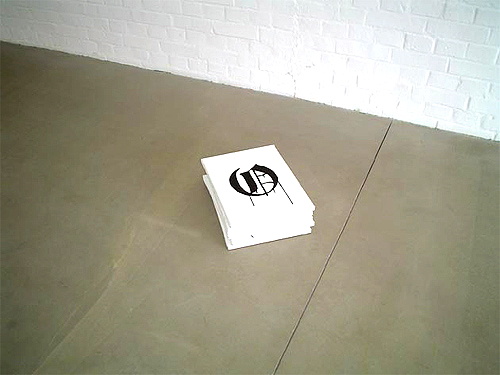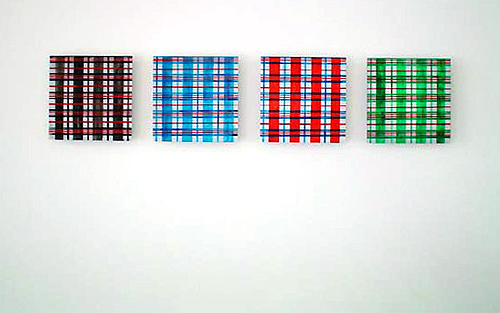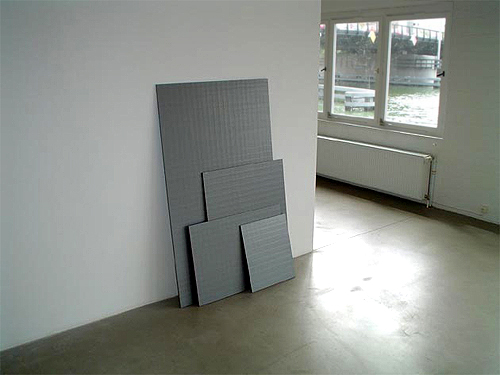

This webpage won't be updated anylonger.
Please visit: www.gerhardsengerner.com
![]()
o.u.t.l.a.w.
 Untitled,
Wallpainting (Free ODB)
Untitled,
Wallpainting (Free ODB)
Acrylic on wall , 205 x 160 cm, ed. 3

o.u.t.l.a.w.
Acrylic on canvas, 6 panels, 30 x 40 cm

Circulation (Bag)
Acrylic on Aluminum, 4 panels, 27 x 27 cm

Untitled (Duct tape)
Duct tape on plywood, 4 panels, dimensions variable

Untitled (Other scene)
Wood, plywood, paint, Dimensions variable
Press release
Gardar Eide Einarsson
o.u.t.l.a.w.
Opening reception: September 6. 2003, 18.00
Duration: September 6 – November 1. 2003
o.u.t.l.a.w. the title of Gardar Eide Einarsson’s first show with c/o
– Atle Gerhardsen takes its name from a work consisting of six painted
canvases. Lying in a stack on the floor each painting bears a letter, together
spelling out the work outlaw. Representing the artist’s traditional
longing and desire for romantic notions of the outlaw, the stack of paintings
however do not let the whole word be visible, showing only the first/ top
letter O (zero).
In the same room overlooking this work is a large scale wallpainting made
from a smaller found image of the artist Old Dirty Bastard (of the Wu Tang
Clan) bearing the inscription Free ODB Aka Big Baby Jesus. The wallpainting
uses the image of Old Dirty Bastard as a sort of anti institutional anti-hero
and a kind of archetypal (tragic) lumpen messiah. In the background plays
a song called “Your Home is Where You’re Happy”, with lyrics
about leaving the repressive institutions of society sung by sixties cult
leader Charles Manson.
The larger room deals specifically with an economy of the inbetween, existing
in the cracks and blind spots of official economic structures. Untitled (Other
Scene) are three 1:1 models of fruit vendor stalls from Chinatown in New York,
painted in the color of the international business newspaper The Financial
Times. Taking their name from Etienne Balibar’s ideas of “the
other scene of politics” they attempt to represent an unrepresented
politics (and economics), underlining the potential for this kind of economics
to function as a platform and support structure for other activities. Surrounding
these sculptures are two works utilizing signifiers of this kind of “lumpen”
economy – the chequered, woven polypropylene bags that are used around
the world to transport goods on a small scale, and “duct tape”
the silver cloth tape that is used to patch up, fix and build (makeshift)
structures.
The works continue Gardar Eide Einarsson’s exploration of how institutions,
both smaller and larger, are negotiated and how ways are found to escape them
and work with different degrees of belonging and non-belonging in relation
to them. At the same time a sub-theme of the exhibition can be glimpsed with
the smaller room functioning as a mock up of the artist studio and the larger
room as exhibition space, dramatizing the relationship between art production
(and the desires that underlie it) and institutions of display and mediation.
Gardar Eide Einarsson, born 1976 in Oslo/ Norway, lives and works in New York
and Berlin. He is currently the holder of Norway’s artist in residence
program at Künstlerhaus Bethanien.
Gardar Eide Einarsson
o.u.t.l.a.w.
Eröffnung: 6. September 2003, 18 Uhr
Ausstellungsdauer: 6. September – 1. November 2003
o.u.t.l.a.w. – der Titel der ersten Einzelausstellung Gardar Eide Einarssons
in Zusammenarbeit mit c/o – Atle Gerhardsen bezieht sich auf ein gleichnamiges,
aus sechs Acrylgemälden bestehendes Werk. Zu einem Stapel aufeinander
geschichtet, trägt jede Leinwand einen Buchstaben, die zusammen das Wort
outlaw (Gesetzlosigkeit) ergeben. Die traditionelle Sehnsucht und das Verlangen
des Künstlers nach der romantischen Idee der Gesetzlosigkeit repräsentierend,
läßt der Stapel von Gemälden jedoch nicht das gesamte Wort
sichtbar werden, sondern zeigt lediglich den ersten/oberen Buchstaben O (Null).
Das Werk optisch erweiternd befindet sich in diesem Raum ein Wandgemälde,
die Vergrößerung einer im kleinerem Format aufgegriffenen Darstellung
des Künstlers Old Dirty Bastard (Mitglied des Wu Tang Clan), das die
Inschrift Free ODB Aka Big Baby Jesus trägt. Das Wandgemälde arbeitet
mit dem Image Old Dirty Bastards als eine Art anti institutionellem Anti-Held
und archetypischem (tragischem) Lumpenmessias. Im Hintergrund ist der Musiktitel
“Your Home is Where You’re Happy” zu hören, dessen
Text das Verlassen repressiver gesellschaftlicher Institutionen thematisiert,
gesungen von sechziger Jahre Kultfigur Charles Manson.
Die Arbeiten in dem größeren Raum beschäftigen sich mit der
Wirtschaft des Dazwischen, existent in den Rissen und toten Winkeln der offiziellen
ökonomischen Struktur. Untitled (Other Scene) besteht aus drei 1:1 Modellen
von Obst- und Gemüseverkaufsständen aus Chinatown in New York, gestrichen
in der Farbe der internationalen Handelszeitung The Financial Times. Ihren
Namen den Theorien Etienne Balibar’s zu der “anderen Szene der
Politik” (“the other scene of the politics”) entlehnt, versuchen
sie nicht-vertretene politische (und wirtschaftliche) Ansichten zu repräsentieren,
indem sie das Potential dieses Wirtschaftszweiges als Plattform und tragende
Struktur für andere Aktivitäten unterstreichen. Die Skulpturen umringend
sind zwei weitere Werke platziert, die mit den Symbolen dieser Form der “Lumpen”
Wirtschaft arbeiten – die karierten, gewebten Polypropylentaschen, die
auf der ganzen Welt zum Transport von Waren benutzt werden und “Panzerband”,
das silberfarbene Gewebeklebeband, welches zum Reparieren, Fixieren und Stabilisieren
(behelfsmäßiger) Aufbauten verwendet wird.
Die Arbeiten erweitern Gardar Eide Einarsson’s Untersuchungen zu der
Frage, in welcher Weise Institutionen, kleine sowie große, mit Individuen
verhandeln und wie Wege gefunden werden können, dem zu entrinnen und
mit ihnen in verschiedenen Graden der Zugehörigkeit und Nicht-Zugehörigkeit
zu arbeiten. Gleichzeitig ist auch die Tatsache, daß der kleinere Raum
als ein Modell des Ateliers des Künstlers und der größere
Raum als Ausstellungsraum funktioniert, als ein Unterthema der Ausstellung
zu nennen, welches die Beziehung zwischen der Kunstproduktion (und den Sehnsüchten,
denen sie unterliegt) und den Vermittlungs- und Ausstellungsinstitutionen
dramatisiert.
Gardar Eide Einarsson, 1976 in Oslo/ Norwegen geboren, lebt und arbeitet in
New York und Berlin. Als Stipendiat des OCA (Office for Contemporary Art)
ist er im Rahmen des internationalen Atelierprogrammes derzeit Gast im Künstlerhaus
Bethanien.